Denon on and On
Denon is in the midst of their 100th Anniversary celebrations, which means they have producing electronic components for a century. The company has long been a favorite amongst audiophiles producing some of the most beloved audio units in the industry. Over time, Denon also became known for their quality video components, such as A/V Receivers and DVD Players. They have been one of the manufacturers at the forefront of universal disc player manufacturing, making some of the best DVD/CD/SACD/DVD-A players on the market. I still own a Denon DVD-2200 universal player. So it should come as no surprise that Denon would move into the universal Blu-ray player arena – even if they have done it a bit late. Competitors such as Oppo have been doing it and doing it cheaper. Never the less, Denon entered the fray, first with standard Blu-ray universal players, and now, at last, with Blu-ray 3D universal players, like the BDP-1611UD.
The BDP-1611UD is Denon’s entry-level universal disc player. When it comes to formats, it handles just about everything but the kitchen sink. It plays DVD, CD, Blu-ray, Blu-ray 3D, SACD, DVD-A, MP3, WMA, AAC, and can even handle JPEG picture files. The 1611UD also includes the internet services Netflix and YouTube, although at the writing of this review, the YouTube service has still not been activated.
“D” is for Design
The 1611UD is a typically-designed Denon unit with a two rack space body in gunmetal black. Out of the box, the player feels hefty and sturdy, just as a Denon should. One problem with the 1611UD, however, is that the disc tray feels a bit flimsy in comparison to older Denon models and even other brands. The disc tray on my Panasonic Blu-ray player feels like it is made out of steel in comparison to this Denon, which feels like rubber. The flat faceplate has a rounded top edge. The power button is on the left front of the unit and it glows with a red ring around it when it is in standby and green when the unit is powered on. Also on the left, but to the right of the power button are the Disc Layer button that allows switching between the different layers on a hybrid SACD and selection of multichannel or two channel programs on SACDs and DVD-As. Rather perplexingly, the button also allows for switching between the standard DVD layer and Blu-ray Disc Layer of the nearly nonexistent single-sided hybrid Blu-ray Disc.I say “nearly nonexistent” because although these sorts of discs are in the Blu-ray specification, as far as I know, there has only ever been one insanely expensive box set of a Japanese television series released in Japan on this format, so why Denon would feel the need to include the function on a button is perplexing indeed.
Also on this side of the player next to the Disc Layer button are the Pure Direct button, which turns off the video and digital outputs for audiophile quality playback through the analogue outs and the Resolution button that cycles through the various video resolutions supported by the component output. In the middle is the disc drawer which sits flat against the faceplate and right under it is the LED display. To the right of the disc tray and display are the basic controls: stop, play, reverse-skip, forward-skip, stop, pause/still, play, disc tray button, and display button. And on the front right bottom are a Source button, which selects playback from optical disc or USB and a USB port, which can be used for additional BD-Live storage (the player has 1GB of storage built-in) and playback of media files. The rear of the unit houses a coaxial digital audio output, an HDMI port, a stereo pair of RCA analogue audio outputs, an Ethernet port and AC in jack for a removable power cord.

The Denon’s remote mirrors the controls on the front of the player and adds in the additional number and color-coded keys plus a picture key that allows access to a number of noise reduction settings, contrast, brightness, and gamma settings. These settings can be adjusted and saved individually to five different banks. I’m certain that most home theatre enthusiasts will stick this remote in a drawer and use something more robust, but I found the Denon’s remote to be quite functional with all the commands you would need. The problem with it is it is impossible to see in the dark and there are no tactile clues to allow you to figure out what buttons do what.
Ready, Set….
Not quite. When the Denon starts up it doesn’t go to a home menu, but rather it brings up a wallpaper screen. This can be adjusted in the Video Setting:TV:Wallpaper menu to either Picture (which displays the Denon logo against a black backdrop), Black, Gray, or Blue. In order to get to the setup screen, you have to hit the setup button on the remote, which is simple enough.
Setting up the 1611UD was a breeze. The settings menus were straightforward and easy to follow. Getting the player onto my home network was very simple indeed, particularly since the 1611UD doesn’t have built-in Wi-Fi, all I had to do basically, was plug it in and activate the networking. Of course, that can be a hindrance for those who do not have a wired network connection located at a reasonable distance from the player.
So, going into the setup menu, I went to General Settings:System and set Screen Saver to On, Auto Power Mode to On, Power Saving to Normal Standby, HDMI Control to Off, HDMI Power Off Control to Off, and Update Notification to On. Under General Settings:Network I set Internet Connection to Enable and BD-Live Connection to Permitted. I then went into the Video Setting menu and set TV Aspect to Wide (16:9), I set Wallpaper to Picture and Progressive Mode to Auto. I set the HDMI Color Space to YcbCr and set HDMI Deep Color to Auto. Initially, the 1611UD did not arrive with 3D capability, which is why it was marketed as 3D-ready, but a few weeks after I received the player from Denon, a firmware update was issued that added the 3D feature to the player. I went back into the Video Setting menu and sure enough, there was a new 3D settings submenu. I set the 3D output setting to Auto and the rather strange TV Screen Size Setting to 55”. This last setting seems a bit perplexing to me, as I do not notice any difference in picture quality or 3D effect regardless of what I set the screen size to and it seems strange to me to have a screen size setting for 3D absent any setting for viewing distance. Moving on to the Audio Setting menu, I set the Coaxial and HDMI outputs to Bitstream, set Downsampling to 192kHz, which effectively turns downsampling off, and set DRC (Dynamic Range Control) to Off.
Waiting for the “Superplayer”
Once I had the 1611UD setup just the way I wanted it, it was time to check its test scores. I ran the latest HQV 2.0 test suites on the 1611UD. With the HQV Blu-ray test suites, the unit was nearly flawless. On the Video Conversion tests the player was perfect on a rotating bar test pattern and rotating bar against a static pattern background pattern, but in a test with three waving bars, there was some very slight stairstepping on the right edges of the lower left three bars. In a video clip with a girl playing a violin, the player was again flawless, showing no aliasing in the strings and showing great detail.
In the Film Resolution tests, the player fell down bit, showing an inability to lock into unusual cadences. In the 30fps Video 2:2 test the 1611UD showed flicker and moiré in the upper stands and never locked in. The 24fps Film with 3:2 cadence had the player locking in quickly and showing no moiré. In Text Overlays on Film (video over film) tests the player handled the processing cleanly, showing smooth text, no flicker or jutter and no combing in the text. The Response Time test was a different matter, however. A test with a ball in a circle switching between 2:2 and 3:2 found that the 1611UD can’t lock in on 2:2 material. In the Multi-Cadence tests DV CAM cadences show heavy jutter, but no moiré. 5:5 and 6:4 animation cadence were the same as was the 8:7 “Anime” cadence.
On the HQV DVD tests, the 1611UD scored exactly the same and in the DVD Color Upsampling tests it showed no issues with Interlaced Chroma Problem or Color Upsampling Error (CUE).
The failure of the 1611UD to handle the unusual cadences or the waving bar test patterns in HD or SD is hardly evidence of its real world performance, however. The chances of coming across Blu-rays or DVDs with those unusual cadences are slim, and I doubt that, for most people, that slight stairstepping that is apparent in the HQV tests will even be noticeable in the course of normal playback.
What Time Do You Have?
One of the biggest complaints about Blu-ray players from the time the format first launched nearly five years ago now is how long they take to load discs. That has been steadily improving over the the years, but the stand-alone players have always lagged behind the Playstation 3 in speed and some manufacturers have been worse than others. After running the benchmarks on the 1611UD, I did some speed tests on it, using my trusty iPad stopwatch app. Here are the results.
Power on time:
Normal standby mode: 24 sec.
Power Saving Standby mode: 24 sec.
Disc load times (from open tray to play menu):
Pirates of the Caribbean: Curse of the Black Pearl — 13:26
Fifth Element (Remastered) – 37 sec
Up — 7:47
Inception — 2:45
As a slight comparison, my Panasonic DMP-BDT350 took 3:11 to load Inception, so the Denon definitely seems speedy according to the numbers and it feels that way during normal operation as well.
That’s Music to My Ears
Since part of the appeal of the 1611UD is the fact that it is a universal player that audiophiles will want to own, I decided the first thing I would do is try out some music discs. The one flaw with the 1611UD is that the only way to get multichannel sound is to use the HDMI output into an A/V Receiver or Pre-Processor/Multichannel Amp setup; otherwise you will be limited to 2-channel only using the RCA outs. This seems to be the way most manufacturers are going, however, especially with their entry-level players.
So, what was it to be, an SACD? A DVD-A? Nope – a Blu-ray Audio Disc! I put in a copy of John Corigliano’s Circus Maximus (Naxos), the disc’s screensaver came up and nothing else happened!
Fortunately, I was able to contact Klaus Heymann, president and founder of Naxos, and Andrew Walton from K&A in London, Naxos’ authoring house, and we determined together that it was definitely an issue with the player. Thankfully my PR contact put me in touch with Chuck Miller at Denon and after a quick and friendly phone call during which we discussed the problem with the disc and some other technical questions I had about the player, the issue was bumped up to Denon’s engineering department. Several weeks later, a firmware update was issued that fixed the problem and the disc played flawlessly.
After trying out the Corigliano disc, I moved on to some SACDs. This is where I discovered another of the 1611UD’s more annoying flaws. For SACD playback the player will always default to the multichannel program on the disc if there is one. It is impossible to set a 2-channel preference. Therefore, for all those multichannel haters out there, you will always have to select 2-channel using the Disc Layer button either on the player itself or on the remote every time you play a multichannel disc. Another nuisance is that the 1611UD cannot switch to the CD layer of a hybrid SACD on-the-fly. You have to stop playback, remove the disc, and select CD before playing the CD layer. My Sony XA-9000ES can switch between layers on the fly and it is eight-years-old.
Onto the discs. I tried Bob Dylan – Blood on the Tracks (Sony) hybrid SACD and it played without issue. I also tried Beck – Sea Change single layer multichannel (Universal) and hybrid stereo (Mobile Fidelity). Both discs played without any issues and they sounded great. Now, I realize that bitstreaming DSD into my Onkyo TX-SR805 AVR I was listening mainly to the DACs on the Onkyo, but I would swear that the Denon sounded better in that sort of setup than my Oppo DV-980H universal DVD player doing the same thing. Perhaps the Denon streams DSD with less jitter? Anyway, I decided to switch the 1611UD HDMI output from bitstream to PCM so I could see what the player would do with the DSD. In this mode the player outputs DSD in 96kHz/24-bit PCM.
Next up I tried out some DVD-As. First I put on The Doors – Morrison Hotel and then moved on to Elton John – Goodbye Yellow Brick Road before finishing up with Neil Young’s – Archives Vol. 1 Disc 08: North Country. Once again, the player gave no playback issues and, I’d swear these discs sounded better on this 1611UD than they do on my Oppo.
I tried the discs again in stereo through the 1611UD’s analogue RCA outputs in the two Pure Direct modes. While the player sounded reasonable good for those who are not too picky, it could not compete against my Sony XA-9000ES SACD/CD player, which just sounded much smoother, more open and airy, especially on SACD playback. Obviously, on DVD-A playback, I had only the Oppo DV-980H to compare, and the Denon easily trounced the entry-level Oppo.
In the Eye of the Beholder
I’d run some tests on the 1611UD and I’d had some listening sessions with hi-res discs that proved rather fruitful, but now it was time to get out the Blu-rays and see how this player looked in the real world. The first thing I noticed was the barebones playback display menu that lacked a bitrate menu. The only information available was disc format, video and audio codec, time, output resolution and chapter information. The first disc up was Inception: Chapter 3 where Leonardo DiCaprio and Ellen Paige are sitting at the sidewalk cafe and the dreamworld explodes around them. The Denon reproduced this scene flawlessly, with sharp details, no sign of any artifacts or aliasing and accurate color reproduction. I was eager to get on to some 3D, so I pulled out Avatar 3D: Chapter 17 “First Flight” and I could see no difference between the 3D effect being produced by the Denon and the one produced by my Panasonic DMP-BDT350. I fooled around with the Denon’s 3D Screen Size setting and watched through the scene a few times, each time with the player set to a different screen size, but I could not see any change in picture quality, 3D depth or pop-out. I put in some more 3D, this time Resident Evil: Afterlife 3D: Chapter 11 where Alice jumps off the top of a building with a group of zombies behind her. Again, the Denon reproduced this scene on my Samsung C8000 the same way the Panasonic did. There is some ghosting, but the depth of field is good and detail is strong. I found the same results with Despicable Me 3D: Chapter 13 “Funland” and Piranha 3D. Lastly, I put on The Fifth Element (Remastered): Chapter 6 in which Leeloo falls into Korben’s cab. The Denon displayed bright, vibrant colors and sharp detail. Mila Jovovich’s hair was as orange as orange could be and the cab was a sunny yellow.
Goin’ Old School
As difficult as it may be to believe, people still have huge DVD libraries, and, yes, some people do actually still go out and actively purchase new DVDs – I, know, shocking! So, with that being the case, any entry-level Blu-ray player with a price tag like this Denon darn well better be good at playing DVDs. So, I pulled out some DVDs to check it out. Revenge of The Sith: Chapter 40 “Battle of the Heroes” where Anakin and Obi-Wan have there big showdown was detailed, if just a tad soft. The columns in the background did show some stairstepping, but this is in the actual image and shows on every player I have ever demoed this disc on. The Denon did not look as film-like playing this back as my reference Panasonic DMP-BDT350, probably due to its lack of a 24p playback mode for DVD as the Panasonic has, but it still looked quite good. Next I tried The Incredibles, Pixar’s animated smash that will soon be heading to Blu-ray. With this CGI gem, the Denon’s less film-like appearance during DVD playback and slightly less reserved color saturation worked to its advantage. The Incredibles on DVD looked about as close to HD as one could get without actually being HD.
It’s Cloudy and That’s a Good Thing
All Blu-ray Player (and Television) manufacturers are moving towards building connected devices that can access the so-called “cloud;” the numerous information and entertainment services on the internet that provide all sorts of content, from on demand HD movies to downloadable apps. Both my Panasonic Blu-ray player and my Samsung television offer numerous connected services like Netflix, VUDU, Picasa, YouTube, Twitter, Facebook, Amazon on Demand, Bloomberg, The Weather Channel, TV Guide and much, much more. Compared to other manufactures, Denon seems rather weak. The 1611UD offers only Netflix and YouTube, and as I mentioned earlier in this review, the YouTube service is not yet activated. I do have a YouTube account, but not a NetFlix account, so I was unable to test either of the services on the player.
Since the 1611UD is in fact also DLNA compliant, I was able to test that funcionality. The player found my networked hard drive without a problem and I was able to search through it and find MP3 files on the drive and play them on the Denon.
The Good:
- Strong HD and DVD playback
- Quick disc loading times
- SACD and DVD-A playback
The Bad:
- No built-in wi-fi
- Few internet services
- No SD card slot
- Poor remote control
- No legacy HDMI 1.3 support
- Flimsy feeling disc tray
The Definitive Word
Despite a few setbacks early on with disc compatibly issues, I found the BDP-1611UD a pleasure to use. It has quick disc loading times and very snappy BD-Live response times, probably due to its on board memory. I still would have liked to see a built-in SD card slot in addition to the USB slot and built-in wi-fi, for a player with a $399 price tag. The lack of a more robust array of internet services is also a bit of a letdown, when other manufacturers are offering far more, often for less, with just as good or even better Blu-ray or DVD playback. Still, the Denon does what it is supposed to do and that is offer a pleasing high-definition picture, more than acceptable DVD playback for folks with a sizable DVD library, and 3D support for the new Blu-ray 3D titles that are beginning to hit the store shelves, all wrapped up in a player that looks and feels like a quality machine.
The Scorecard:
The Design:
[Rating:4.5/5]
Performance:
[Rating:4/5]
Value:
[Rating:3.5/5]
Overall:
[Rating:4/5]
Specifications
- Video Signal system: NTSC
- Audio
- S/N: 115 dB
- Total harmonic distortion: 0.0025%
- Dynamic range : 100 dB
- General
- Power supply: 120 V, 60 Hz
- Power consumption: 25 W; (Standby: 0.6 W)
- Dimensions W x H x D (incl. Protrusions) 17-1/8″ x 4-1/4” x 12-9/16” 434 x 107 x 319 mm
- Weight: 9.3 lbs 4.2 kg
- Ports
- Video
- HDMI output x1
- Component output x1
- Composite output x1
- Audio
- Coaxial digital output x1
- Analog output (2ch, L/R) x1
- Ethernet x1
- USB port x1
- Remote control (IN/OUT) x1
More information:
- Denon DBP-1611UD (MSRP $399)
- https://usa.denon.com
[amazon-product align=”left”]B003V8B0VG[/amazon-product]


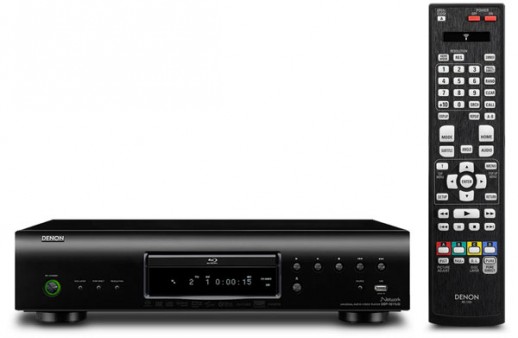
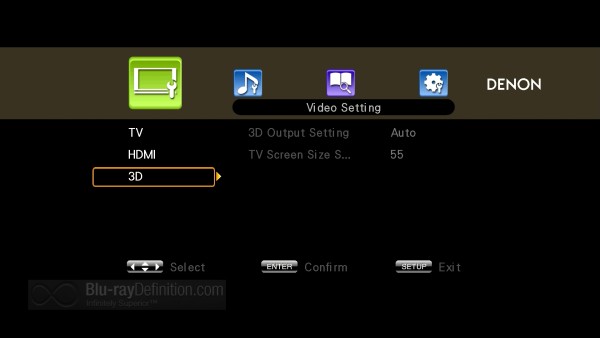
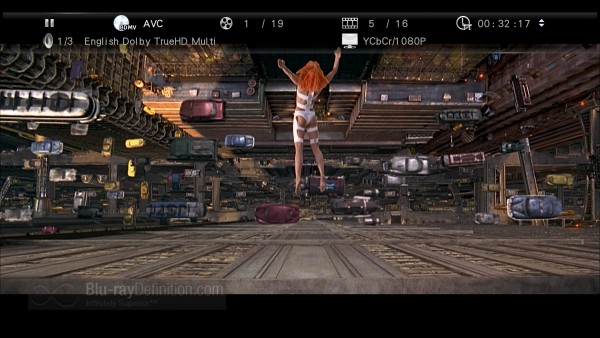
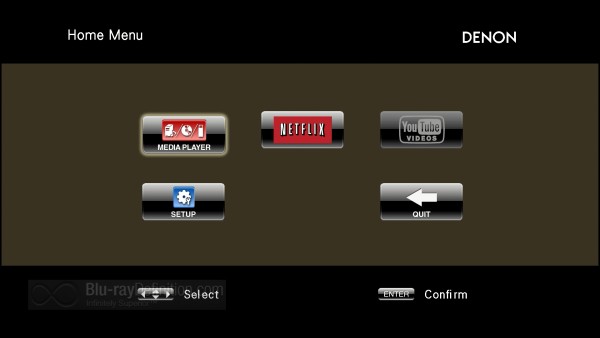
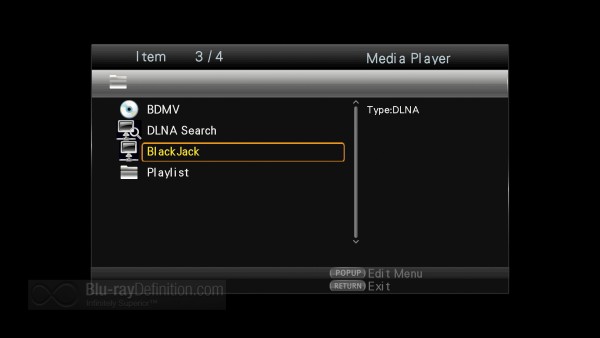


Great review. I have a question. You wrote that the only way of enjoying multichannel audio is trough HDMI. But have you tried the coaxial digital out? I have an old receiver without HDMI but it has coaxial digital so it’s important to know if it works or not for multichannel audio. Thanks
The coaxial output will work for mutlichannel on DVDs and for Blu-ray, but only for the older codecs (Dolby Digital, DTS), you won’t be able to listen to any of the new lossless codecs (DTS-HD Master Audio, Dolby TrueHD) or the new lossy codecs (Dolby Digital Plus, DTS-HD Master Audio High Resolution). Also, multichannel playback on high-res audio formats such as DVD-A or SACD discs won’t work either through coaxial. It also won’t work on any Blu-ray Audio discs that have multichannel audio content encoded in DTS-HD, Dolby TrueHD, or LPCM above 48kHz/24-bit.
Thanks for the question!
Thanks. Very clear answer… I’m gonna have to look for a new receiver soon…
You may want to look into one of the new Onkyo AVRs, they offer really good bang for the buck. :-)